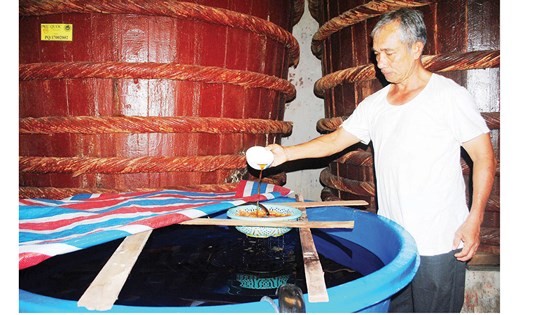
According to Mr. Huynh Quang Hung, vice chairman of the People’s Committee of Phu Quoc District, in the past, the seafood fishing and processing industry, including fish sauce production, was key to the economy of Phu Quoc. During the 2000s, tourism has become the key to the district’s economic development. However, fish sauce production and seafood fishing still contributed greatly to the development of the district as well as its budget. There are 53 traditional fish sauce makers in Phu Quoc with 7,800 wooden barrels. A barrel weighs averagely from 10 to 12 tons. The average output of fish sauce with nitrogen level of 25N is around 25 million liters.
It raised public concerns as some people planned to merge the definition of traditional fish sauce with its industrial counterpart although the methods as well as final products of traditional fish sauce and industrial one are totally different. Traditionally-made fish sauce is made purely from fish and salt and its manufacturing process may take up to two years. Meanwhile, industrial fish sauce is mass produced from water and chemicals.
Showing the geographical indication certificate granted by the European Union, Mr. Hung said that if the standards in the draft were passed, they would put traditional fish sauce makers at a disadvantage. The value that traditional fish sauce makers had put in so much effort to gain the EU’s recognition would be null and void. This value is not only for Phu Quoc Fish Sauce Association, it is also a national asset. Traditional fish sauce production should be nurtured and upheld.
Speaking of the draft, Mrs. Nguyen Kim Chi, the owner of Thanh Khoa Fish Sauce, proposed that it is essential to build two separate sets of standards for traditional fish sauce and industrial fish sauce for consumers to be aware of their differences. As for the burning issue of histamine content limit, Mrs. Chi said that all traditional fish sauce makers know that the presence of histamine in traditional fish sauce is natural as the main ingredient of fish sauce is anchovy. Histamine is produced in the process of fermenting anchovies to make fish sauce. However, the amount of fish sauce a person consumes a day will never reach the level that triggers allergic reactions. Therefore, the draft’s cap on histamine level on fish sauce is inappropriate.
Mrs. Nguyen Thi Tinh, former president of Phu Quoc Fish Sauce Association, said that it must base on research on histamine when setting histamine limit in fish sauce. However, there has been no research on this topic up to now. Phu Quoc District should propose Kien Giang Province to instruct research on histamine in fish sauce production, she suggested.
The opinion of the representative of Masan Phu Quoc that criteria in the draft based on international standards and the standards adopted by Codex Alimentarius Commission met disagreement of several participants at the meeting.
Mr. Vu The Thanh, a food safety expert with the Vietnam Association of Seafood Exporters and Producers, said that both the draft and Codex standards are unreasonable. Traditional and industrial fish sauces must be distinguished clearly before drafting separate sets of standards for each kind of fish sauce instead of equating traditional fish sauce with industrial one. Even Codex standards should be revised, he said.
‘We should make Codex Alimentarius Commission understand the differences between traditional fish sauce and industrial one. By epidemiology, we should prove that despite high histamine level in traditional fish sauce, fish sauce has never caused food poisoning’, Mr. Thanh said.
Mrs. Ho Kim Lien, president of Phu Quoc Fish Sauce Association, said that the association will summarize the opinions of fish sauce makers and experts then send petitions to the National Assembly of Vietnam and the Government to protect traditional fish sauce production.
























